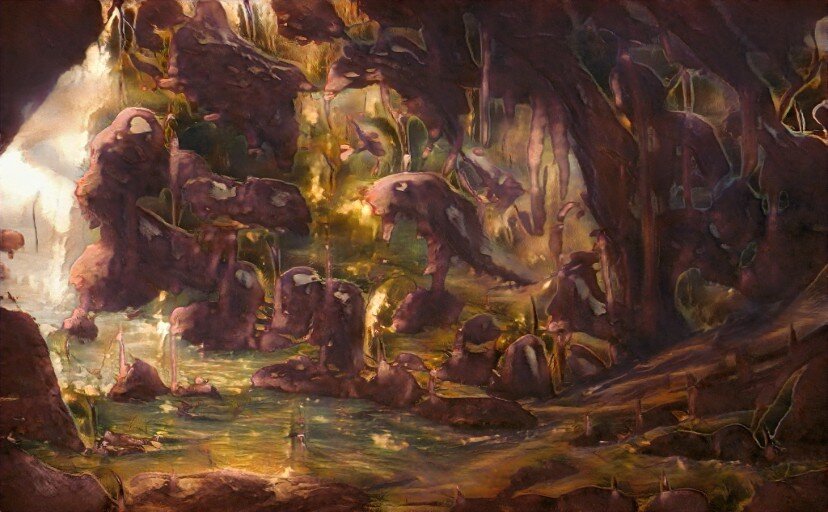Verdial
Verdials, also known as Caudans after their home in Caudal D, are near-Humans with a symbiotic relationship with the alien Caudal lichen that thrives in that cube.
Basic Information
Anatomy
The main body of a verdial is morphologically human, though the suffusion of the lichen symbiote has expanded the person's form into an additional external organ.
A verdial possesses a flexible sheathe of deciduous leaf-like material which grows from an individual's back (especially around the lumbar region), shoulders, and waist. The sheathe wraps around their body before curling slightly away at the edges - leaving the anterior surfaces of the body exposed - in the manner of a long-waised vest; when supine, a Verdial is said to appear as though 'laid on a bed of lettuce.'
The Verdial leaf-sheathe is an external growth from the Caudal symbiote which inhabits the Verdial's body. It contains many more blue-green chloroplasts in much greater quantity than the cells in the rest of the body, taking on shades of blue, green, yellow, orange, or red depending on the individual and season. Because this special organ provides a stand-off between the outer dermis of a Verdial and their epidermis, a Verdial can often survive late-stage treatment for Distal Polyp parasitosis; indeed, Distal polyps seem to ignore Verdials more often than not. Verdial hair follicles tend to be broader and flatter than the base human, making curling more common (though not universal).
Genetics and Reproduction
Verdials reproduce in a similar manner to Humans; fetal Verdials begin the process Verdialization (acquiring the Caudal symbiote proper) in-eutero, though Verdial cells possess chloroplasts and certain genetic alterations from stock Human cells all the way back to the point of fertilization.
It is rare, but possible, for certain mammals to acquire a Caudal lichen symbiote from environmental or interpersonal exposure. This 'contaigious' element often results in discrimination by other species (mostly Humans and Rostrans when Verdials travel beyond their own borders. On the other hand, certain individuals (especially Biocosmists intentionally seek out contact with Verdials in the hopes of acquiring a symbiote. The latter individuals are known as Voluntarist Verdials.
In any event, acquiring a Caudal lichen symbiote when one has not grown up with it is a potentially dangerous process, as, without biology evolved to accept such a symbiote, tissue rejection, infarct, and infiltration of vital organs is possible. As a result, around 5% of all creatures which acquire a Caudal lichen symbiote die within the first year of symbiosis, with a further 10% suffering complications from the process. Medical intervention and vigilance are key for a successful exogenous Verdialization.
Dietary Needs and Habits
The primary biological difference between Verdials and stock Humans is that Verdial cells contain blue-green chloroplasts in addition to the usual organelles. These extra organelles, along with their congenital symbiosis with Caudal lichen, allow Verdials to subsist on less food and oxygen when exposed to sunlight. The mutualistic relationship between Verdials and their symbiotes allows both creatures to benefit from the production of various vitamins and other biochemicals that neither species can normally produce on its own. Verdials must drink more water than usual to use these benefits - and are more vulnerable than most to dehydration and heat stress as a result - but the reduced food requirement especially provides an adaptive benefit in Distal lands, where edible plants and animals are more scarce.
Additional Information
Facial characteristics
Most Verdials have large eyes, a trait evolved to help them discern details in the confusingly-lit bio-luminescent forests of Caudal D. Verdial eye colors can vary within the range of Human eye colors, though red, orange, and even lavender shades are possible due to the influence of a red Caudal lichen symbiote during development.
Sue the the preponderance of airborne spores in the atmosphere of Caudal D, Verdials of both sexes typically have small, narrow noses, and men have difficulty growing thick mustaches or beards (which might hold onto spores). Verdials with at least one Human parent are exceptions to this rule.
Angela Foxglove, CEO of the Ghostleaf Foundation and a female Verdial with a congenitally albino Caudal symbiote.
Geographic Origin and Distribution
Most Verdials reside within the Caudal Tesseract, though their ancestral Human need for exploration and trade have caused some to spread into the wider Manifold. Most humanoids who intentionally live within the Distal Tesseract are Verdials, as they are less vulnerable to Distal polyp parasitosis and skin cancer caused by the preponderance of ultraviolet light in that tesseract.
Average Intelligence
As human
Genetic Ancestor(s)
Genetic Descendants
Scientific Name
Homo Sapiens Plantatum
Lifespan
Verdials can live up to 160 years with proper healthcare, though some particularly venerable individuals have lived to 200.
Average Height
As Human
Average Weight
As Human
Average Physique
Verdials tend to have better muscle tone and thicker skin in general than standard humans due to bodily infiltration by the symbiote.
Body Tint, Colouring and Marking
The flesh of a Verdial tends to have the pale cast of fungal tissue, while the hair and sheathe tend towards blues, greens, and oranges depending on season and individual genetics. Fully 10% of the Verdial population possesses a Caudal lichen symbiote manifesting congenital albinism, with a pale or white sheath. Verdial hair has a leafy, blade-like, or petal-like appearance and matches the color the sheathe.
Exposure to ultraviolet light gradually causes the appearance of dark patches and strands within the skin, with the pattern often being described as being reminiscent of birch or aspen bark. With continued exposure (i.e. from residing within the Distal Tesseract), these patches eventually merge, rendering the individual a dark black color. While this darkening effect can come and go over time based on levels of exposure, individuals tend to manifest a characteristic pattern of darkened regions on their skin throughout their lives
Geographic Distribution
Related Organizations
Related Ethnicities
Related Myths






Comments